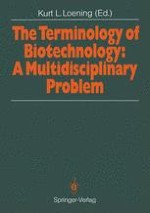1990 | OriginalPaper | Buchkapitel
Nomenclature in the Field of Eicosanoids
verfasst von : A. L. Willis, W. L. Smith, D. L. Smith, R. Eglen
Erschienen in: The Terminology of Biotechnology: A Multidisciplinary Problem
Verlag: Springer Berlin Heidelberg
Enthalten in: Professional Book Archive
Aktivieren Sie unsere intelligente Suche, um passende Fachinhalte oder Patente zu finden.
Wählen Sie Textabschnitte aus um mit Künstlicher Intelligenz passenden Patente zu finden. powered by
Markieren Sie Textabschnitte, um KI-gestützt weitere passende Inhalte zu finden. powered by
Eicosanoids are oxygenated derivatives of polyunsaturated fatty acids (PUFAs), generally of 20 carbons in chain length and often with important biological activity; the PUFAs themselves can be named according to a shorthand nomenclature describing chain length, degree of unsaturation and position of the double bond nearest the terminal methyl (“omega”) carbon. Arachidonic acid (20:4ω6) is the archetypal precursor for all main classes of the eicosanoids. Prostaglandins (PGs) A-J (ring type) are further classified as to degree of unsaturation in the side chains (eg PGE1 has one such double bond) and also according to stereochemistry; thromboxanes (A or B, according to ring type) have similar nomenclature.Leukotrienes (LTs) have a characteristic conjugated triene system and are almost always formed via 5-lipoxygenation. LTA compounds are 5(6) epoxides and LTB compounds are characteristic dihydroxy compounds. LTs C-D are peptidolipids each with a specific amino acid characteristically attached via sulfur to carbon 6 of the fatty acid moiety. Lipoxins (LXs) are characteristic trihydroxy compounds derived by 15-lipoxygenation via an epoxy-15-hydroxy intermediate. LXAs have a 5,6-dihydroxy region and LXBs have a 14,15-dihydroxy region. Both LTs and LXs are (like PGs and TXs) subclassified according to degree of side chain unsaturation. Nomeclature of other oxygenated PUFA metabolites (HEThs etc) is logically adapted from previous usage. Nomenclature of PG-like (prostanoid) receptors are classified into EP, FP, DP and TP types whose characteristic natural agonists are (respectively) E-type PGs, F-type PGs, D-type PGs and thromboxane A2 but are better defined by response to more specific synthetic prostanoids and newly developed specific antagonists. It is now recognized that the EP receptor may be subclassifled into EP1, EP2, and EP3 receptors. Recently, subclassification of peptidoleukotriene receptors has been proposed (PLT1, PLT2a, PLT2b, PLT2c and PLT2d) and for LTB receptors (LTB41a and LTB41b. Proposals for more accurate nomenclature for enzymes that form anl metabolize eicosanoids are discussed.
